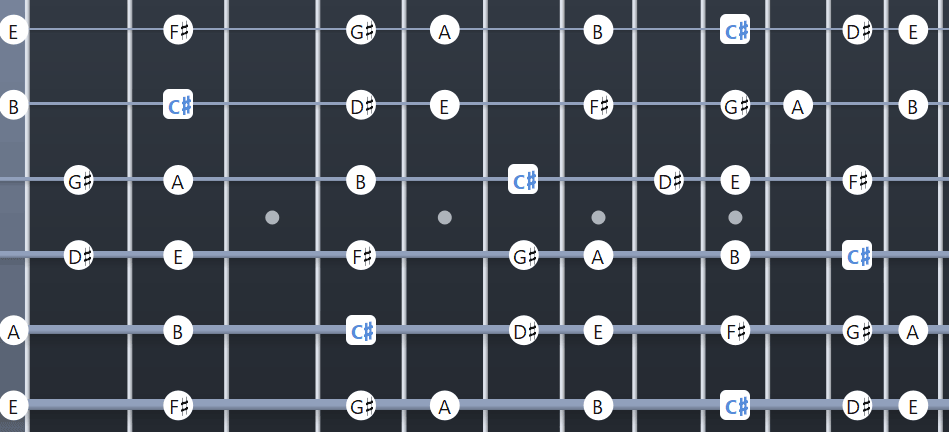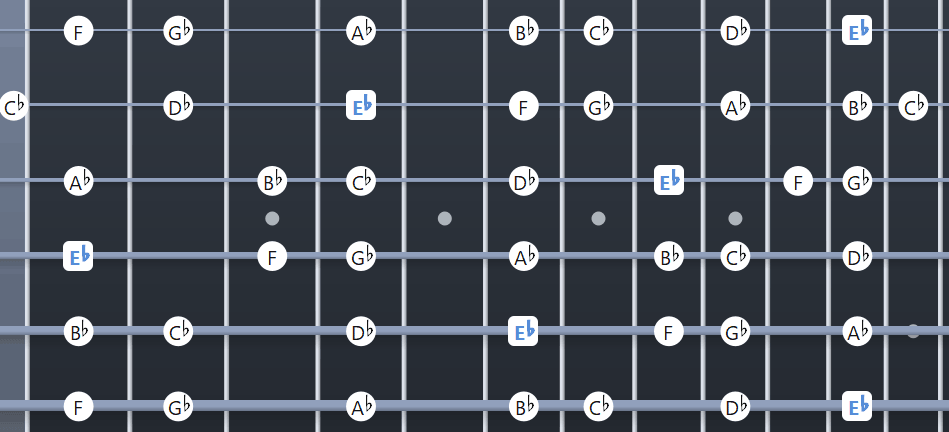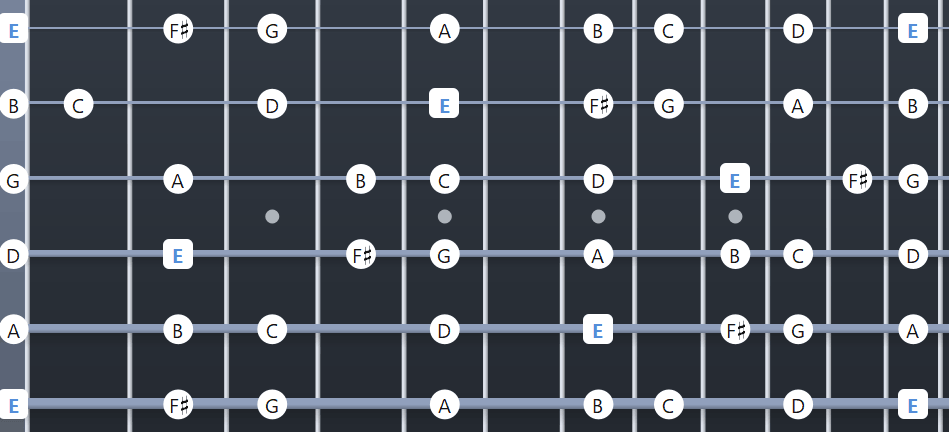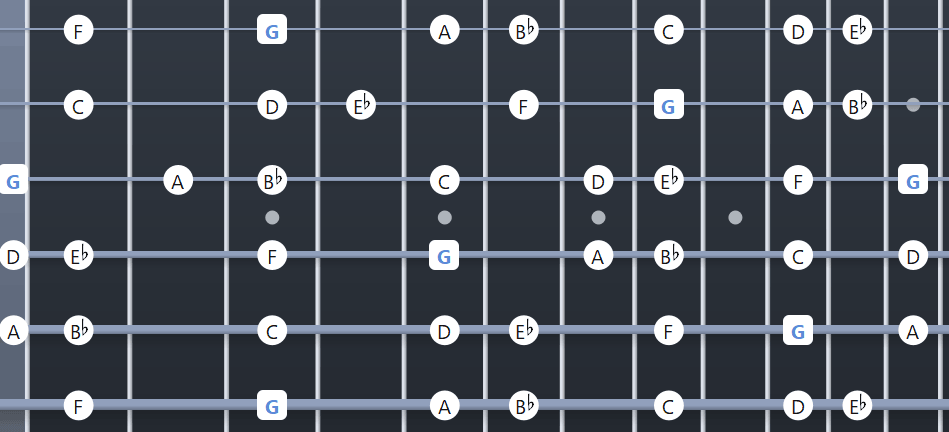The Aeolian mode is the sixth mode of the Major scale and is an easy mode to learn and use.
Before you learn Aeolian or any other modes, I recommend first learning the Ionian mode to give you a basic starting point.
This guide will look at:
- What the Aeolian mode is
- How the Aeolian mode compares to other modes
- Basic Music Theory and Mode Formula
- Fretboard Diagrams for Every Aeolian Mode on Guitar
- How to Use the Aeolian Mode
- Songs Using the Aeolian Mode
After reading this guide, read this guide to learn how to practice modes and scales.
What is the Aeolian Mode
The Aeolian mode is the sixth mode of the Major scale. This means the Aeolian mode can be built by looking at the sixth note of any Major scale.
Aeolian mode uses the same notes as the Natural Minor Scale. This means if you know any minor scales, you also know the Aeolian mode.
While the Aeolian mode and the Natural Minor Scale use the same notes, thinking in modes is very different from thinking in scales. Treat the Aeolian mode just like any other mode instead of thinking of it as the minor scale.
This can be confusing at first, but if you have spent time learning about other modes, it will begin to make sense.
Aeolian Mode Formula
The Aeolian mode can be understood with a formula that compares it against the Major scale. Understanding mode formulas will help you understand the difference between each mode.
The formula for the Aeolian mode is: 1 2 b3 4 5 b6 b7
Because so many guitarists are familiar with the sound of the Natural Minor Scale, the Aeolian mode will likely sound very familiar when you play it.
The best way to understand the Aeolian mode is to compare it against closely related modes.
If you compare Aeolian with the Dorian mode, the only difference is the sixth note. Aeolian uses a b6 (minor sixth) and Dorian uses a 6 (Major sixth). Both Aeolian and Dorian use a b3 and a b7, which give them their dark/minor qualities. Because Aeolian uses a minor sixth, it’s a darker/sadder sounding mode compared to Dorian.
If you compare Aeolian with the Phrygian mode, the only difference is the second note. Aeolian uses a Major second while Phrygian uses a minor second. This means Phrygian is darker/sadder than Aeolian.
Practice changing back and forth between Aeolian and Dorian or Phrygian and you’ll learn to hear the unique qualities of Aeolian. With enough practice, you’ll stop thinking of Aeolian as just the minor scale and you’ll be able to use it as a mode.
As you might expect, the Aeolian mode works best when played over the top of a minor chord.
How to Find The Notes in Aeolian
There are three different methods you can use to find the notes in any mode.
Modes are often confusing at first because different books and videos will use different methods to explain modes, so you end up with a confusing blur of explanations.
I’ll go through the three easiest ways to find the notes in the Aeolian mode and you can decide which method makes the most sense to you to use.
Method 1: Use the Mode Formula
The first method to figure out the notes in any mode is to use the mode formula as mentioned earlier.
The formula for Aeolian is: 1 2 b3 4 5 b6 b7
To use this formula, pick a root note for the mode you want to figure out.
Here are the steps to using the mode formula to find the notes in any mode:
- Choose a mode to learn
- Find the Major Scale that starts on the same note
- Use the mode formula to change that scale into the mode
Let’s go through these steps with a couple of examples to show how you can use the formula to figure out any Aeolian mode. But the same above steps apply when learning other modes.
Example 1: C Aeolian
Let’s say you want to figure out the notes for C Aeolian.
The root note (the first note) for C Aeolian is C. This means to use the mode formula, we need to start with the notes in the C Major Scale. You simply find the scale that matches the starting note C.
Here are the notes of the C Major Scale:

Now we can use the Aeolian formula (1 2 b3 4 5 b6 b7) to change the C Major scale into the C Aeolian mode.
The ‘b’ before the numbers 3, 6 & 7 tells us that those notes need to be lowered by one semitone or a half-step (one fret on guitar). We call b3 a flat third, b6 a flat sixth, and b7 a flat seventh (learn about intervals here).
The third note in the C Major Scale is E. When we lower this by one semitone (one fret), we get Eb (E flat).
The sixth note in the C Major Scale is A. When we lower this by one semitone (one fret), we get Ab (A flat).
The seventh note in the C Major Scale is B. When we lower this by one semitone (one fret), we get Bb (B flat).
All the other notes stay the same as they are in the C Major Scale.
Here’s a chart comparing the C Major scale to the notes in the C Aeolian mode:

By changing the third, sixth, and seventh notes in the C Major scale, we end up with all the notes in the C Aeolian mode.
The notes in C Aeolian are: C D Eb F G Ab Bb
Example 2: A Aeolian
The root note (the first note) for A Aeolian is A. This means to use the mode formula, we need to start with the notes in the A Major Scale.
Here are the notes of the A Major Scale:

The formula for Aeolian is 1 2 b3 4 5 b6 b7 so we need to lower the third, sixth, and seventh notes in the A Major scale by one fret to find the notes for A Aeolian. All the other notes stay the same.
The third note in the A Major Scale is C#. When we lower this by one semitone (one fret), we get C.
The sixth note in the A Major Scale is F#. When we lower this by one semitone (one fret), we get F.
The seventh note in the A Major Scale is G#. When we lower this by one semitone (one fret), we get G.
Here’s a chart comparing the A Major scale to the A Aeolian mode:

So the notes in A Aeolian are: A B C D E F G.
The sharps and flats used to create modes may be confusing if you are new to music theory, so think of them as shifting up or down a fret at a time. If you see ‘b3’, it just means take the ‘3’ note and move it down one fret. If you see a ‘#4’, it just means to take the ‘4’ note and raise it by one fret.
The starting note could be anything (eg: C#, Eb, F) and it doesn’t make any difference – just move it down one fret to find the new note (raising Bb by one fret is B).
Practice taking other Major scales and turning them into the Aeolian mode using the above formula and steps.
Method 2: Match the Major Scale
The second method is to figure out which Major scale matches the mode you want to find.
There are seven modes of the Major scale – one built from every note in the scale.
Aeolian is the sixth mode of the Major scale, so Aeolian is built using the sixth note of the Major scale.
Example 1: A Aeolian
We want to find a Major scale that uses the note ‘A’ as the sixth note in the scale.
An easy way to do this is to look up a chart of Major scales to find the one that uses A in the sixth position.
The other way is to look at the note three frets up from your chosen Aeolian mode root.
Three frets up from A is C, so the matching Major scale for A Aeolian is the C Major scale (C D E F G A B).
This means the C Major scale and the A Aeolian mode use the same notes. The only difference is A Aeolian starts on A and C Major starts on C.
You can also see that A is the sixth note in the C Major scale, so we know we have found the correct scale.
So the notes in A Aeolian are: A B C D E F G.
Example 2: E Aeolian
We want to find a Major scale that uses the note ‘E’ as the sixth note in the scale.
You can look up a chart of Major scales to find the one that uses E in the sixth position.
The other way is to look at the note three frets up from your chosen Aeolian mode root.
Three frets up from E is G, so the matching Major scale is the G Major scale (G A B C D E F#).
This means the G Major scale and the E Aeolian mode use the same notes. The only difference is E Aeolian starts on E and G Major starts on G.
You can also see that E is the sixth note in the G Major scale, so we know we have found the correct scale.
So the notes in E Aeolian are: E F# G A B C D.
As the Aeolian mode and the Natural Minor Scale both use the same notes, the easiest way to find any Aeolian mode is to just find the matching minor scale.
So if you want to play D Aeolian, you simply find the notes to the D minor scale.
While this method is obviously far easier than any other method covered here, I recommend you spend time practicing using the other methods.
By practicing the other methods, you’re learning how the Aeolian mode is formed. You get to build up a good understanding of Aeolian just by using these methods.
You won’t get the same benefit if you just look up the minor scale. If you truly want to learn how to use modes, take some time to practice using these three methods.
Method 3: Build Using Intervals
The third method is to build the mode using intervals and an interval formula.
Intervals are the building blocks of scales as explained in detail in this lesson.
Learning how to build a scale or mode using intervals will help you understand what makes each mode or scale different.
The way you build the Aeolian mode using intervals is similar to how we built the mode using the formula covered earlier.
The interval formula for the Aeolian mode is: W H W W H W W
W = whole-tone (two frets on guitar)
H = half-tone or semitone (one fret on guitar)
To use this formula, you pick the mode you want to build (eg: C Aeolian), then follow the formula to figure out the rest of the notes.
Once you learn how to do this, you’ll see that you can easily build any Aeolian mode you want without having to know any Major or minor scales.
The added benefit of practicing this method is that you’ll also be able to quickly find the notes to any minor scale using the same interval formula.
Example: E Aeolian
Here’s a fretboard diagram showing how simple this method is to work out the E Aeolian mode:

Here are the steps explained:
- Start on the root note for the mode (eg: E for E Aeolian)
- Move up two frets to find the next note for any W in the formula
- Move up one fret to find the next note for any H in the formula
- By the end of the formula, you should end up on the same note as the root one octave higher (eg: E for E Aeolian)
Once you memorize the formulas for all seven modes, you can easily find all the notes to any mode without having to look up any scale.
This method might seem like a lot of work at first, but if you have memorized the notes on the fretboard, you’ll find that this is an incredibly quick and easy method to use.
With enough practice, you’ll be able to figure out any mode on the fly while improvising. Being able to instantly switch between different modes while jamming is possible when you’re able to think about them with intervals.
Aeolian Mode Reference Chart
Here is a handy reference chart showing all possible Aeolian Modes:

Every Aeolian Mode Fretboard Diagram
There are 12 possible Aeolian modes to match the 12 notes we can play on guitar.
Before we look at how to use the Aeolian mode as well as songs that use Aeolian, here is a fretboard diagram for every Aeolian mode you can play on guitar.
A Aeolian Fretboard Diagram
The notes in A Aeolian mode are: A B C D E F G

Bb Aeolian Fretboard Diagram
The notes in Bb Aeolian mode are: Bb C Db Eb F Gb Ab

B Aeolian Fretboard Diagram
The notes in B Aeolian mode are: B C# D E F# G A

C Aeolian Fretboard Diagram
The notes in C Aeolian mode are: C D Eb F G Ab Bb

C# Aeolian Fretboard Diagram
The notes in C# Aeolian mode are: C# D# E F# G# A B

D Aeolian Fretboard Diagram
The notes in D Aeolian mode are: D E F G A Bb C

Eb Aeolian Fretboard Diagram
The notes in Eb Aeolian mode are: Eb F Gb Ab Bb Cb Db

E Aeolian Fretboard Diagram
The notes in E Aeolian mode are: E F# G A B C D

F Aeolian Fretboard Diagram
The notes in F Aeolian mode are: F G Ab Bb C Db Eb

F# Aeolian Fretboard Diagram
The notes in F# Aeolian mode are: F# G# A B C# D E

G Aeolian Fretboard Diagram
The notes in G Aeolian mode are: G A Bb C D Eb F

G# Aeolian Fretboard Diagram
The notes in G# Aeolian mode are: G# A# B C# D# E F#

How to Use the Aeolian Mode
The best way to learn how to use the Aeolian mode is to spend time jamming with it over the top of a minor chord.
For example, use a looper pedal to record yourself strumming an E minor chord or an Em7 chord.
Now you can jam over the top of that chord using the E Aeolian mode. Try coming up with licks and melodies and listen to how the mode sounds over the top of the chord.
Make sure you match the minor chord to the root note of the mode you’re using. So if you want to jam in A Aeolian, play over an A minor chord or an Am7 chord.
The Aeolian Sound
When you play through the notes in the Aeolian mode, you may not notice any notes standing out. All the notes will likely sound ‘normal’.
Because we’re so used to the sound of the minor scale, the Aeolian mode sounds just as normal to us.
This means if you want to learn the Aeolian sound, you need to spend time changing back and forth between Aeolian and other modes.
For example, try playing the below notes (E Aeolian) over the top of an E minor chord:

The b3, b6, & b7 have been highlighted in the above Guitar TAB to make it clear which notes have been altered compared to the Major scale.
Listen to how each note sounds compared to the sound of the backing chord.
Now do the exact same thing playing the E Phrygian, E Ionian, or E Dorian mode.
Suddenly, you’ll hear certain notes stand out as strange sounding. When you go back to Aeolian, you’ll hear how different Aeolian sounds.
For example, after playing E Dorian, you might notice how the sixth note in E Aeolian stands out. It has a darker or sadder sound compared to the sixth note in Dorian.
If you were to skip playing this sixth note, you wouldn’t hear any difference between Aeolian and Dorian. That means the sixth note helps give Aeolian its distinct sound.
It’s the same when comparing Phrygian and Aeolian. If you were to skip the second note, you wouldn’t hear any difference between the two modes.
Changing back and forth between modes is the best way to truly learn a mode, so spend plenty of time playing back and forth between every mode.
Songs Using the Aeolian Mode
It can be tough to identify the Aeolian mode in music because many guitarists tend to write songs using the minor scale. While the minor scale and Aeolian both use the same notes, they’re not used in the same way.
In one way, every time you hear the minor scale, you’re also hearing the Aeolian mode. There are countless examples of songs using the minor scale. But a lot of songs that use the minor scale play around with other minor scales (eg: melodic and harmonic minor). This means you’re often not hearing ‘Aeolian’ – you’re hearing a mix of minor scales.
Another way to think of Aeolian is to think of it as a separate thing from the minor scale. We think of every other mode as separate things, so try to think of Aeolian in the same way.
Here are some songs that use the Aeolian mode:
- All Along the Watchtower by Jimi Hendrix
- Losing My Religion by R.E.M.
- Hello by Adele
- Somebody That I Used to Know by Gotye
The above songs have a distinct Aeolian sound. Listen carefully to these songs after spending some time jamming with Aeolian and you’ll be able to hear when Aeolian is used.
Look up the Guitar TAB for these songs and see if you can figure out exactly what Aeolian mode is used in each one. Compare the notes used in the song against the fretboard diagrams from earlier and you can figure out each mode.
Aeolian Mode FAQs
Here are some common questions you might have about the Aeolian mode.
Is Aeolian Mode the Same as Minor?
The Aeolian Mode uses the same notes as the Natural Minor Scale. Some musicians think of Aeolian and minor as the same thing, while others think of Aeolian as a separate thing compared to the minor scale.
They both use the same notes, so the only difference is how you think about and use modes vs scales.
What is Aeolian Mode Used For?
The Aeolian mode is extremely popular in a wide range of music styles because it is versatile and has a familiar sound. It’s a stable-sounding mode compared to Phrygian or Locrian, while still giving you plenty of dark or sad-sounding qualities.
What is the Difference Between Dorian and Aeolian?
Dorian and Aeolian modes both use a flat third and a flat seventh. The only difference between Dorian and Aeolian is the sixth note. Aeolian uses a flat sixth or a minor sixth while Dorian uses a Major sixth.
This means Dorian has a brighter sound when you use the sixth note compared to the darker sound of the Aeolian mode.
Here are more useful guides on the modes and practicing them:
- Guide to Ionian Mode
- Guide to Dorian Mode
- Guide to Phrygian Mode
- Guide to Lydian Mode
- Guide to Mixolydian Mode
- How to Practice Guitar Scales and Modes
- How to Memorize the Fretboard
- More guides on modes coming soon
